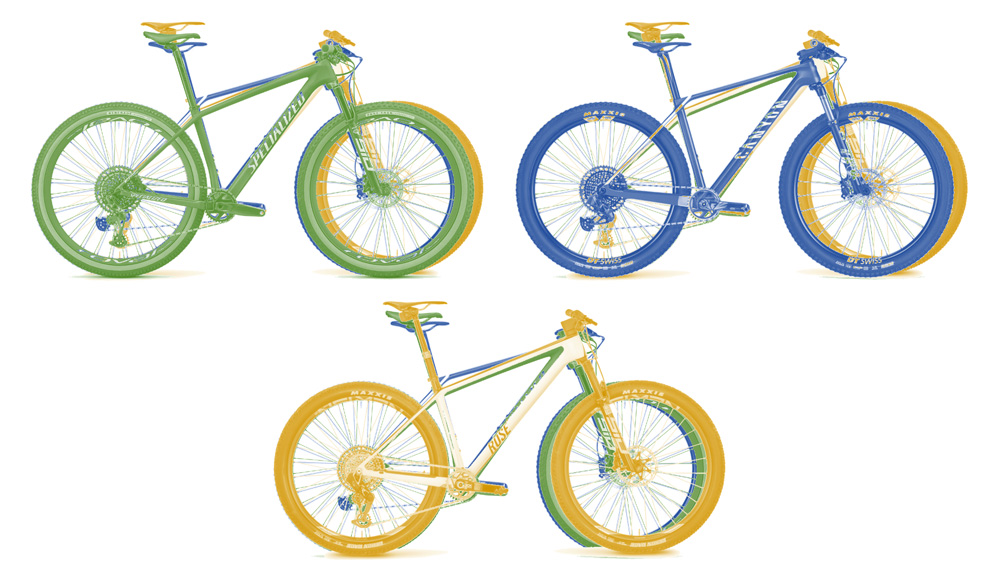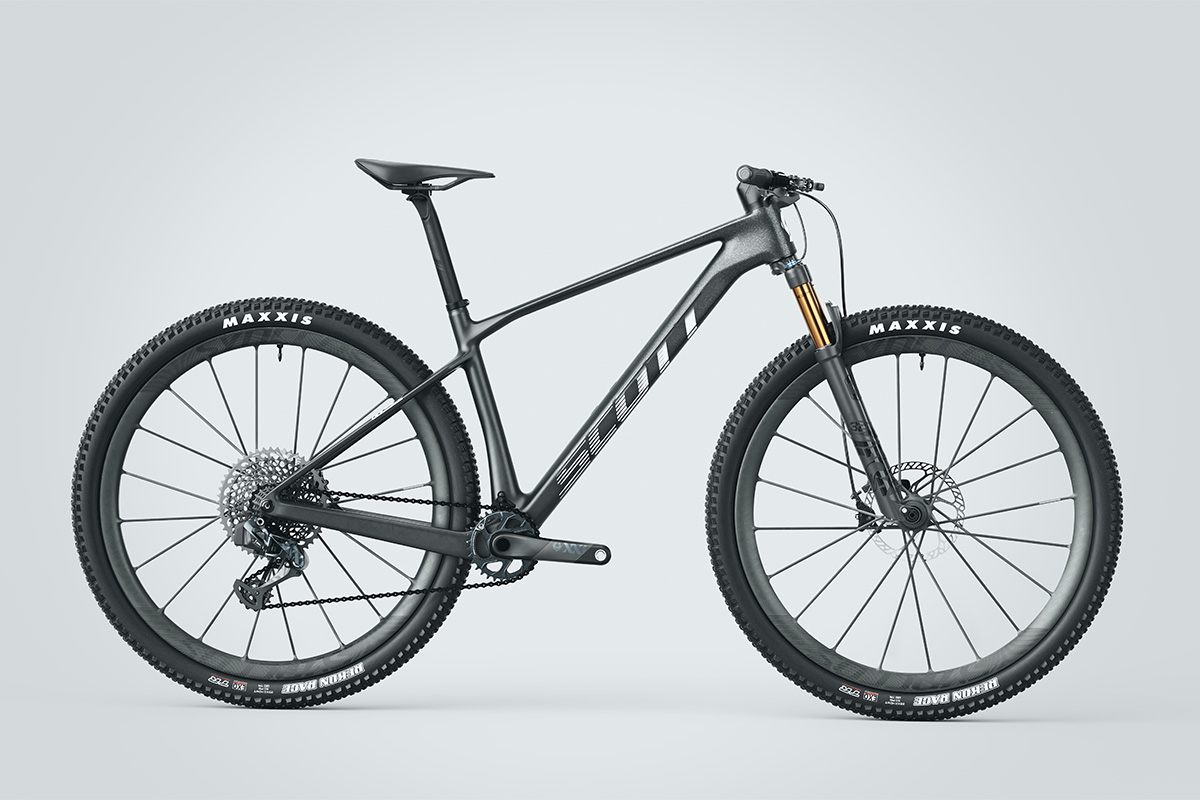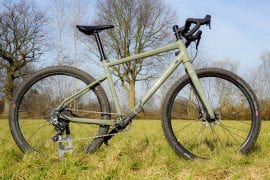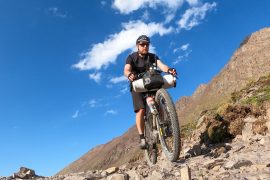When it comes to riding and having fun off-road, gravel bikes have clearly evolved in recent years from a “marketing trend” to a great all-round bike for most tours in the forest and on tarmac. And that’s a good thing. The classic mountain bike has also modernised and is being ridden more and more in Bikepacking, when it comes to demanding and also longer tours in the terrain and especially also in Bikepacking Endurance Races.
The advantages of wider tyres, the comfort of a suspension and the safety of a different geometry are already known to the manufacturers of gravel bikes, which is why they are also – depending on the model and orientation – developing more and more in the direction of MTBs, or are significantly influenced by them.
But this is not about whether the MTB is the better gravel bike. Each type of bike has its justification and in the end it’s about which bike you feel comfortable with and on which bike you feel comfortable outdoors. I myself ride the Salsa Fargo, an MTB with a drop bar, and thus have a perfect mix of both worlds, with which I’ve managed well everywhere so far.

Through my evaluations of the bikes ridden on the big ultra bikepacking races like Silk Road, Atlas, Hellenic or Tour Divide, I see that MTBs are becoming more and more popular, especially on the former races. And this is of course because the nature of the course and the tracks simply require an MTB and it is often easier and more comfortable and also safer to ride an MTB.
At the Bohemian Border Bash Race, the majority were on gravel bikes, but quite a few were also on mountain bikes. And every now and then during the race I thought that I should have put on MTB tyres and perhaps installed a suspension system. But for the BBBR, I still think that a gravel bike with the right riding skills is the better choice.
Now I’m planning for next year and if everything works out, there’s a need for an MTB. Of course, I could fit my Fargo with a suspension fork and do all that with it. But that doesn’t have to be the case, because there are a lot of very good MTBs out there, where I would then do N+1 for once and get myself an XC hardtail.
And because I like to share my thoughts with you, I now present my shortlist of possible MTB candidates. And one of the bikes will be it. I have a clear favourite – but I won’t announce it until I have it.
I’ll say it right away: this list has no claim to completeness, is purely subjective and certainly “forgets” some great MTBs. If that’s the case, feel free to add to it and give reasons in the comments.
And: the comparison pictures are only visual and not data-based comparisons. Where available, I have included BikeInsights data. Otherwise, of course, this is also error-prone, but it is only meant to show differences in frame shape.
My MTBs/Hardtails for Bikepacking & Racing
Canyon Exceed
You can already call it a classic, because the Canyon Exceed basically has everything that a very good XC hardtail needs: sensible suspension, a light and stable frame, a good frame triangle that allows for panniers and bottles and – depending on the model variant – good to very good equipment. And compared to all the other bikes in this article (except for the Specialized Epic HT – see below), the geo or frame of the Exceed is “more upright”, slopes down less towards the seat tube and also has the most space in the frame triangle.
Canyon classifies the Exceed into CF and CF SLX. The latter are relatively new and feature an even lighter frame (carbon) and testing at XC races. They are now also equipped with UDH derailleur hanger and carbon cockpit. A 100mm RockShox SID acts as the suspension. Although it would work, unfortunately there are currently no models with the new SRAM AXS transmission. At least I haven’t seen any models yet.
The CF series of the Exceed is more or less the “entry-level series”, where the focus is on the price/performance ratio. The frame is also made of carbon, but a little heavier. As with the CF SLX, all frame sizes have 29-inch wheels.
The Exceed is very popular and was also the most ridden model at this year’s Silk Road Mountain Race. Nils Thomsen successfully rode the Atlas Mountain Race 2023 and Brian Lautenschlager the Trans Balkan Race.
If I were to choose the Exceed, it would be the Exceed CF SLX with Sram GX AXS.
It has a Fox suspension fork with 100mm travel, SRAM GX AXS with 34 in the front and 10-52 in the rear, SRAM Level hydraulic disc brakes, a carbon wheelset from DT-Swiss, carbon handlebars and seatpost.
In addition – and this applies to all the bikes mentioned in this article – I would fit Ergon bar ends and an Aerobar.
The only thing that bothers me is the integrated saddle clamp, because when it’s loaded it’s hard to reach and if there’s a defect, you can’t fix it. In Bohemia I met a rider who had problems with his integrated clamp (not Canyon, but Rose) and therefore had to make compromises.
But I expect Canyon to give the Exceed CF SLX an update after all, because the following bike puts Canyon under a bit of pressure from my point of view…
Rose PDQ
After many years of only offering the Psycho Path as a hardtail MTB (which was also a bit outdated), Rose has now introduced the “Pretty Damn Quick” PDQ, a hardtail MTB that is obviously pretty good. Luisa Werner and Sebastian Breuer rode prototypes of this bike at the Atlas Mountain Race and both were obviously not only successful but also very satisfied. Sebastian then also rode the bike in the Silk Road Mountain Race and it made him successful there as well.
The PDQ is a hardtail with a 120mm suspension fork, a carbon frame, a carbon cockpit (I don’t know what I think about that yet. But it’s only available on selected models), the latest shifting technology (SRAM AXS Transmission) and overall very light.
If you believe the first tests and the expert assessment of MTB-News, the adapted geometry with its flatter steering angle makes the bike very agile and sporty overall. There is even talk of an all-rounder that combines the advantages of an XC hardtail with those of a trail/downcountry bike.
The Rose PDQ even comes with dropper posts, so nothing stands in the way of off-road fun. However, I would then remove these. Important or at least interesting: Rose uses flat-mount brakes and not post-mount, as is usually the case with MTBs.
There are currently four models in the PDQ series. All are very well equipped and weigh between 8.9 and 10.9 kg.
My choice would be either the PDQ2 or 4. I am a SRAM fan and convinced by the electronic AXS shifting system of the Americans. In addition, only the transmission models are used here, which I consider contemporary in the MTB sector. The frame triangle of the PDQ is also large enough to accommodate bottles and bags.
Both models are equipped with carbon rims. The PDQ2 has a RockShox SID Base suspension fork with 120mm travel and the PDQ4 has a new RockShox SID Ultimate with 120mm travel. The PDQ4 model has the fully integrated Rose carbon cockpit, where stem and handlebar form one unit and the cable routing elegantly disappears. The PDQ2 has a classic stem and carbon handlebars.
In terms of weight, the two bikes don’t differ much (although 1.3kg is a lot): the PDQ2 weighs 10.8kg, the PDQ4 9.5kg. However, due to the higher-quality components (SRAM GX and SRAM XX-SL), the price is about 3,000 euros between the two. But for that you can choose the model 4 in elegant black, while the model 2 comes in Oak Mild and Borealis Green.
Unfortunately, the PDQ is so new that there is no geo-comparison data on Bike Insights and Geometry Geeks yet. But if you look at the PDQ in comparison to the Canyon Exceed, the difference is quite clear.

What I don’t like about the PDQ, like the Canyon Exceed, is the press-fit bottom bracket. But I could replace it with the Torktide PF bottom bracket from Enduro Bearings. But my next candidate shows that it can be done differently…
Specialized Epic Hardtail/Epic World Cup
Of course, Specialized belongs in this series of very good bikes for bikepacking. I have been a fan of the Specialized Epic Hardtail for a long time. In addition to the pure Hardtail, there is also the Hardtail Comp, Hardtail Expert and the S-Works Hardtail. Unfortunately, the presentation on the website is not really clear and you have to click on each model to find out what equipment is hidden behind it.
This MTB classic was among the most ridden models at the AMR, HMR and SRMR this year and comes with a 100mm suspension fork, a – depending on the model – very light carbon frame, carbon rims and – on every model – a 73mm BSA bottom bracket. On the S-Works model, the Americans add a powermeter as standard.
When it comes to gears, the Epic Hardtail relies mainly on SRAM (as far as I can see). Mostly the mechanical groupsets are still installed here (1×12), only the S-Works Epic Hardtail model uses an electronic AXS XX1. There is still no sign of transmission here.
My favourite model here would probably be the Specialized Epic Expert, although I’m actually waiting for an update of the line-up and here a model with AXS or even transmission. Mechanical really doesn’t need to be more, or there should be more electronic choices in addition to mechanical.
In terms of geometry, the Specialized is similar to the Rose. I really like the frame shape with the slightly curved seat tube. And in terms of colouring, Specialized is also very tasteful in my view. The frame triangle is also big enough for bags and bottles, similar to Canyon or Rose.
But with the new S-Works Epic World Cup and World Cup Pro, Specialized has gone one better and has a bike on offer that has a very high price (12,500 euros/9,000 euros), but offers a very interesting concept: in addition to a suspension fork, the Epic WC has a so-called SID WCID suspension that is integrated into the top tube. This turns a hardtail into a full suspension bike with 75mm rear travel and 110mm front travel on the RockShox SID SL Ultimate Brain.
I find this concept really interesting, because it means that with a total weight of only 9.2 or 10.3 kg I can use a bike that is a normal hardtail and also rides like one, and if necessary and in difficult terrain I can switch to a fully. Suitable for the typical ultra bikepacking races.
The Epic WC is also equipped with the SRAM AXS X0/XX SL transmission.
But Specialized is not completely alone with this new concept, because the next candidate follows a similar concept…
Trek Procaliber/Supercaliber
If you look at the bikes at Bikepacking Races, you will often see the Trek Procaliber XC MTB. Here, too, the focus is on XC races, which is why the models are consistently brushed for performance. And: in addition to carbon, the Procaliber is also offered with an aluminium frame (at least as a frameset).
And Trek has also built a little additional suspension into the frame: it’s called IsoSpeed, sits at the transition from the saddle to the top tube and is supposed to smooth out minor bumps.
So I find that interesting. However, the frame triangle on the Trek is smaller than on the other models. That makes it a bit more difficult to fit frame bags and bottles. Or rather, there is not much space there, which you should take into account when packing and the required volume when bikepacking.
If the Procaliber were an option for me, I would choose the 9.8 model. Trek uses Shimano and installs the 1×12 mechanical Shimano XT here. In addition, the carbon wheels, handlebars, saddle and seatpost come from Bontrager, the in-house brand.
The suspension fork is a 100/120mm FOX Performance 32 and the bottom bracket is a PressFit from e*thirteen. The crank is also from e*thirteen. The total weight is 10.3kg, but this can be further optimised.
In terms of gearing, the Procaliber is almost identical to the Orbea Alma (see below). However, it is more upright than the Specialized Epic, with a stack to reach ratio of 1:33 to 1:29.
But like Specialized, Trek has been offering the Supercaliber (for much longer), an XC/Fully MTB that has special suspension in the frame and can thus be used from hardtail to full. 80mm in the rear and 110mm in the front are supposed to make riding on trails and difficult terrain as comfortable as possible. Trek calls this rear damping IsoStrut and, like Specialized, uses RockShox technology (RockShox SIDLuxe).
Within the Supercaliber you can choose between SL and SLR. The difference lies in the carbon frame, with the SLR being particularly light.
In the Supercaliber there are models with Shimano (XT/XTR) and SRAM AXS (GX/XX/X0). So there is something for every taste. In terms of price, the Supercalibres are on the higher shelf and range from 3,700 euros to 11,600 euros. If, then I would take a look at the Trek Supercaliber SLR 9.8 GX AXS Gen 2 here. And from the looks of the pictures, the GX AXS Transmission is already available here.
Orbea Alma
When we talk about very good XC bikes, then Orbea cannot be missing, of course. Jochen Böhringer uses the bikes of the Basques for his races, especially the full-suspension Oiz, with which he also rode the Silk Road Mountain Race this year. And Paul Voss also rides the cooperative’s gravel bikes (and maybe soon the XC MTBs at the Cape Epic).
For me, the Orbea Alma would be particularly suitable. The Alma is the race hardtail MTB from Orbea and is available either with a particularly light carbon frame, the so-called OMX Carbon with 830g. Or with an aluminium frame. The carbon frames are made in China, the aluminium frames in Spain. Orbea also offers the option of further customising your model, for example by changing the suspension fork or the wheelset. Or you can choose from a wide range of colour and frame design options. And you can even have your name printed on it.
I’ll be honest: for me, only SRAM AXS comes into question, and preferably the Transmission. Unfortunately, there’s nothing on the Alma yet (or I’ve overlooked it), but at least the SRAM GX AXS is available. So my choice would be either the Orbea Alma M21 2023 or the Orbea Alma M Pro 2023. I also like the fact that they use the very good Shimano XT or XTR brakes here and don’t stick to one brand. And that UDH derailleur hangers are already installed here, which then enable transmission.
The fork is the FOX32 with 100mm travel, together with the carbon handlebars, the carbon wheelset of the in-house brand Oquo Mountain Performance MP30TEAM with DT-Swiss 350 hubs and XTR brakes with 170mm crank. Then the price of the M Pro model is around 6,000 euros.

In terms of geometry, the Alma is very similar to the Canyon Exceed. Both have a similar stack/reach ratio of 1:37/1:35 and are (of course) rather sportier; the Canyon a little more so. There is a clearer difference to the Specialized Epic, which is a little more stretched with a StR ratio of 1:29 (+22mm in the reach compared to the Alma), even though the frame shapes are very similar.
And if you like more suspension, you should take a look at the Orbea Oiz – which, by the way, is already available with transmission.
Scott Scale & Spark
Scott is also on my list with its Scale, but also with its Spark. During this research, however, I noticed that the majority of the models reviewed here are priced very high. Somehow there seem to be no limits any more – at least if you look for electronic shifting.
The Scale is the classic XC hardtail from the Swiss Americans. There is nothing to complain about in terms of equipment. All models come with a 100mm suspension fork and are then, depending on the model, equipped with correspondingly high-quality components. I took a look at the Scott Scale RC World Cup model, which has SRAM AXS, but at 7,500 euros is out of my willingness.
But the Scott Scale RC Team Bike looks good, equipped with Shimano XT and available for only half the World Cup price. The team bike weighs 10.6kg, with RockShox SID suspension fork and Syncros wheelset.
The Scale’s stack to reach ratio of 1:33 is the same as the Trek Procaliber, which is slightly (14mm) shorter than the Scott. The Orbea Alma is slightly more upright than the Scott with a StR ratio of 1:37 and almost 16mm shorter in the reach. So the geo is a bit more aggressive/sporty in comparison.

However, the Scott Spark is also interesting. A special feature is the swingarm on the rear triangle, which turns this bike into an XC full.
The so-called NUDE suspension system can be adjusted and controlled. And as with the Specialized or Trek models above, this is an interesting solution also for bikepacking races, which means more comfort. And keeps the frame triangle as free as possible. Since the SRAM AXS-equipped models are also very expensive here, I took a look at the Spark RC Team Bike. This also comes with Shimano XT and costs 5,000 euros with a weight of 11.7 kg.
Cervelo ZHT-5
Since a short time, XC hardtails may also be called Cervelo. With the Cervelo ZHT-5, the Canadians have a very powerful and beautiful bike on the market, which has successfully accompanied Max Riese, among others, on some of the toughest bikepacking races.
The 1 kg light frame and the obviously very well functioning geometry of the ZHT-5 seem to be convincing. The ZHT-5, the Scott Scale (green) and the Trek Procaliber (blue) are similar in terms of the geo and frame shape (of course, this is not a scientific comparison, just a visual one):

For me, the GX AXS model would come into question. It already has the new transmission. But since I would have to get used to the colour, I might also look at the GX Eagle model. Both cost around 5,000 euros. And they have BSA bottom brackets, which I find very good, since most XC hardtail bikes come with press fit.
However, I would probably replace the Race Face ARC wheels with my Beast XC30.
Conclusion XC MTBs for bikepacking & racing
Of course there are other XC hardtails that would be very good and very suitable for bikepacking and racing. For example the
- Simplon Razerblade
- Mondraker Podium
- Wilier USMA SLR
- Vitus Rapid
- Cannondale Scalpel HT
- Sour Pasta Party
- Veloheld Iron
- Bombtrack Cale AL or
- Bombtrack Beyond+ or the
- Brother BigBro
What I have noticed is that throughout – with a few exceptions – the prices are very high. I don’t have a problem spending a lot of money on bike things, but that surprised me, also because many models are at and far above 10,000 euros.
Now I’m spoilt for choice. Important for me: 29 inch, light frame, good suspension, preferably more than 100mm in the front, space in the frame triangle, geometry suitable for endurance, up to 2.4 inch tyre clearance, SRAM GX AXS transmission (if possible, at least with UDH already prepared/equipped).
What would be your favourite?
And here you can give feedback directly and tell me which of the presented MTBs would be your favourite, which bikes you can recommend and what your favourite MTB gear would be. I’ll then incorporate your feedback results later so that we all get something out of it.
And if you can’t see the embedded form, you can find the feedback form here (Microsoft Forms/anonymous).



)
)

&w=1600&h=900&fmt=auto)

&w=1600&h=900&fmt=auto)










